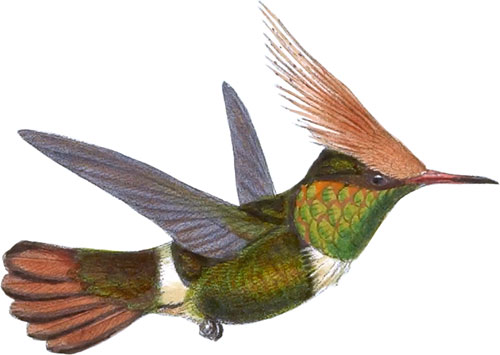If, in the course of my ornithological labours, I have seldom named new birds after individuals, it is not that I think there are not many living naturalists worthy of such an honour, but because I consider the practice an objectionable one; my opinion being that specific appellations should always express some peculiarity pertaining to the species to which they are applied: entertaining then this view of the subject, I must say, that, although fully sensible of the compliment paid me by M. Lesson, in naming the present bird after myself, I should have been better pleased if some more appropriate appellation had been given to such a beautiful species; a species, moreover, which is so rare in the collections of Europe, that few of them contain examples.
The first specimen known,—that from which M. Lesson took his description,—forms part of Mr. Leadbeater’s collection; another single example, gracing that of Mr. Loddiges, was brought to this country by the celebrated traveller Burchell. Those in my own collection were obtained by the indefatigable collector, Mr. Hauxwell, who shot four or five males and two females near the city of Para; these, with two or three more from the Upper Amazon, deposited in other collections, are nearly if not all that are known. It is evidently a continental species,—that is, it is never found, like its near ally the L. ornatus, in Trinidad or any other of the West Indian Islands. North Brazil and the banks of the Amazon, from the embouchure of that mighty river to its upper ramifications in Peru, are, I believe, its true habitat; and its rarity with us is doubtless due to the infrequency with which those remote districts are visited by travellers and collectors, for there seems to be no reason for supposing that in its own particular province it is less numerous than its congeners. In size and structure it very closely assimilates to L. ornatus, but the neckplumes, which in that species are light chestnut-red, are always pure white, and have the terminal spangles broader and rounder; it is also more delicate in form, a feature observable in both sexes. Of its habits and manners nothing is known.
The male has the head and crest rich chestnut-red; upper surface and wing-coverts bronzy green; wings dark purplish brown; across the lower part of the back a band of white; rump chestnut-brown; upper tail-coverts bronzy green; tail dark chestnut-red, the two central feathers bronzy green on their apical half, and the lateral ones broadly edged with brownish black; forehead and throat luminous green; on each side of the neck a series of graduated white plumes, with a large spangle of luminous green at the tip of each; under surface bronzy green; bill fleshy red, becoming dark brown at the tip.
The female has the head and upper surface golden green; a narrow band of white across the lower part of the back; upper tail-coverts tipped with dark bronzy brown; tail bronzy green at the base, crossed by a broad dusky band, and tipped with buff; lores and throat rust-red; under surface bronzy green.
The figures are of the natural size, and represent the males engaged in one of the numerous aïrial combats which so frequently occur among the species of the present genus.
 Lophornis ornatus
Tufted Coquette
Lophornis ornatus
Tufted Coquette
 Lophornis magnificus
Frilled Coquette
Lophornis magnificus
Frilled Coquette
 Lophornis Regulus
Great-Crested Coquette
Lophornis Regulus
Great-Crested Coquette
 Lophornis Delattrei
DeLattre’s Coquette
Lophornis Delattrei
DeLattre’s Coquette
 Lophornis Reginæ
Spangled Coquette
Lophornis Reginæ
Spangled Coquette
 Lophornis Helenæ
Princess Helena’s Coquette
Lophornis Helenæ
Princess Helena’s Coquette
 Lophornis adorabilis
Salvin’s Coquette
Lophornis adorabilis
Salvin’s Coquette
 Lophornis pavoninus
Roraima Coquette
Lophornis pavoninus
Roraima Coquette
Featuring all 422 illustrated species from John Gould’s A Monograph of the Trochilidæ, or Family of Humming-Birds arranged by color.